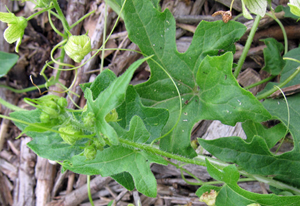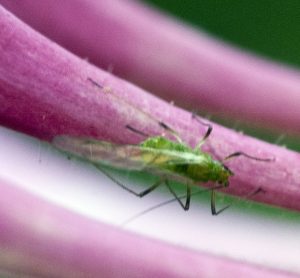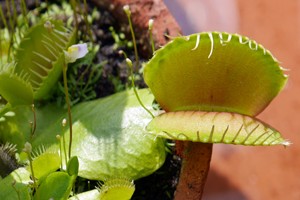A sense of touch in plants.

Climbing plants like sweet peas can ‘feel’ their way around a support, a twig or fencing. Charles Darwin, who had an interest in climbing plants, described Clematis as a leaf climber. Clematis has compound leaves with three to five leaflets, It uses the stalks of the leaves or the leaflets to climb. Darwin noted that contact with another structure was enough for the leaf stalk / petiole to start bending around it. This ability to respond to touch is termed thigmotropism. It is a growth response. The growth rate on the side of the stem that touches the 'support' is slower than on the side opposite the point of touch. As a result the stem begins to curl around the support. The same response is seen in plants that climb using tendrils, such as White Bryony. Its tendrils are thin, wiry structures along the stem that ‘reach out’ into the space around a plant until they come into contact with something they can ‘grab’. Once contact is made, the tendril curls, forming a coil.
 This sense of ‘touch’ has recently been investigated using Thale or Mouse Ear Cress. It has been shown that the veins of the leaves respond to touch. The investigators used small glass beads to apply a small but distinct pressure, and recorded a series of rapid electrical signals (not dissimilar to those seen in nerves). Even when the veins were removed from the surrounding leaf tissue, they still showed electrical activity so the response was not reliant on surrounding cells. The electrical activity was also associated with proton pumps (moving hydrogen ions). The sensitivity of the veins to touch may be associated with the plant’s defence mechanism. Animals like aphids use their mouthparts (stylets) to penetrate the vascular tissue in the veins. The jasmonate system is involved in wound response.
This sense of ‘touch’ has recently been investigated using Thale or Mouse Ear Cress. It has been shown that the veins of the leaves respond to touch. The investigators used small glass beads to apply a small but distinct pressure, and recorded a series of rapid electrical signals (not dissimilar to those seen in nerves). Even when the veins were removed from the surrounding leaf tissue, they still showed electrical activity so the response was not reliant on surrounding cells. The electrical activity was also associated with proton pumps (moving hydrogen ions). The sensitivity of the veins to touch may be associated with the plant’s defence mechanism. Animals like aphids use their mouthparts (stylets) to penetrate the vascular tissue in the veins. The jasmonate system is involved in wound response.
 Another plant, the Venus fly trap (Dionaea muscipula), also responds to touch. It catches prey (insects and spiders) by means of touch. Dionaea catches its prey with a trap, formed from the terminal portion of each of the plant's leaves. The trap is activated by tiny hairs on the inner surfaces of the trap. When a hair is touched by an insect or spider crawling along the leaves, the trap prepares to close but it only snaps shut if the hairs are touched again, within approximately twenty seconds of the first stimulus.
Another plant, the Venus fly trap (Dionaea muscipula), also responds to touch. It catches prey (insects and spiders) by means of touch. Dionaea catches its prey with a trap, formed from the terminal portion of each of the plant's leaves. The trap is activated by tiny hairs on the inner surfaces of the trap. When a hair is touched by an insect or spider crawling along the leaves, the trap prepares to close but it only snaps shut if the hairs are touched again, within approximately twenty seconds of the first stimulus.
Comments are closed for this post.
